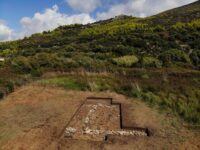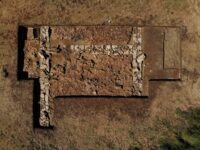 The remains of a lost temple of Poseidon that was famous in antiquity have been discovered in the village of Kato Samiko in the western Peloponnese peninsula of Greece. Archaeologists unearthed large sections of the foundation of a building 9.4 meters (30.8 feet) wide with heavy stone walls .8 meters (2.6 feet) thick. The remains have been dated to the 6th century B.C.
The remains of a lost temple of Poseidon that was famous in antiquity have been discovered in the village of Kato Samiko in the western Peloponnese peninsula of Greece. Archaeologists unearthed large sections of the foundation of a building 9.4 meters (30.8 feet) wide with heavy stone walls .8 meters (2.6 feet) thick. The remains have been dated to the 6th century B.C.
Known from ancient sources Strabo and Pausanias, the sanctuary of Poseidon in Samikos was the regionally important religious center of the six cities of Triphylia. They joined together as an amphictyony, a confederation dedicated to the defense, maintenance and reverence of a cult site. From Book VIII of Strabo’s Geographica:
Then comes the mountain of Triphylia that sees Macistia from Pisatis; then another river called Chalcis, and a spring called Cruni, and a settlement called Chalcis, and, after these, Samicum, where is the most highly revered temple of the Samian Poseidon. About the temple is a sacred precinct full of wild olive-trees. The people of Macistum used to have charge over it; and it was they, too, who used to proclaim the armistice-day called “Samian.” But all the Triphylians contribute to the maintenance of the temple.
 Scholars have proposed based on ancient descriptions that the temple of Poseidon was on a plain below the ancient acropolis of Samikon whose remains are on the hilltop overlooking the Ionian Sea. Geophysical surveys in 2017, 2018 and 2021 also found evidence of walled construction. This year archaeologists from the Ephorate of Antiquities of Ilia, the Austrian Archaeological Institute, the University of Mainz and the University of Kiel (Dr. Dennis Wilken) embarked on the first comprehensive excavation of the site as part of a five-year program to explore the area to identify the sanctuary and the ancient port of Samikos.
Scholars have proposed based on ancient descriptions that the temple of Poseidon was on a plain below the ancient acropolis of Samikon whose remains are on the hilltop overlooking the Ionian Sea. Geophysical surveys in 2017, 2018 and 2021 also found evidence of walled construction. This year archaeologists from the Ephorate of Antiquities of Ilia, the Austrian Archaeological Institute, the University of Mainz and the University of Kiel (Dr. Dennis Wilken) embarked on the first comprehensive excavation of the site as part of a five-year program to explore the area to identify the sanctuary and the ancient port of Samikos.
Thick layers of roof tiles fill the space between the walls. Based on the anomalies of the geophysics, a building of at least 28 m (92 feet) in length can be calculated, which had two interior rooms as well as a pronaos and an opisthodome or adyton. The elongated large building can be nothing other than an Archaic temple located on the site of the sanctuary of Poseidon, perhaps even dedicated to the god himself.
In connection with the fragments of a laconic roof, the discovery of a marble perirrhanterion provides evidence for dating the large building to the Archaic period. The large marble vessel itself, imitating a bronze bowl, is characteristic of the inventory of a sanctuary.
This discovery allows new perspectives on the political and economic importance of the amphictyony of the Triphylian cities in the 6th century BC, for whom the sanctuary of Poseidon at Samikon formed the centre of their religious and ethnic identity.